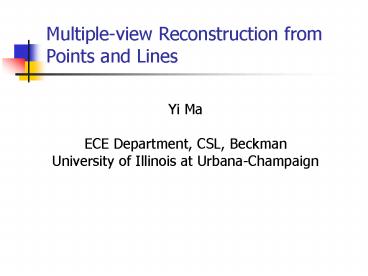Multiple-view Reconstruction from Points and Lines - PowerPoint PPT Presentation
Title:
Multiple-view Reconstruction from Points and Lines
Description:
Title: UCLA Extension Short Course Author: Stefano Saotto Last modified by: Jana Kosecka Created Date: 9/21/2002 4:11:23 PM Document presentation format – PowerPoint PPT presentation
Number of Views:85
Avg rating:3.0/5.0
Title: Multiple-view Reconstruction from Points and Lines
1
Multiple-view Reconstruction from Points and Lines
- Yi Ma
- ECE Department, CSL, Beckman
- University of Illinois at Urbana-Champaign
2
Problem formulation
Input Corresponding images (of features) in
multiple images. Output Camera motion, camera
calibration, object structure.
3
Projection model point features
Homogeneous coordinates of a 3-D point
Homogeneous coordinates of its 2-D image
Projection of a 3-D point to an image plane
4
Image of a line feature
Homogeneous representation of a 3-D line
Homogeneous representation of its 2-D co-image
Projection of a 3-D line to an image plane
5
Incidence relations among features
Multiview constraints are nothing but incidence
relations at play!
.
.
.
6
Traditional multifocal constraints
For images of the same 3-D point
(leading to the conventional approach)
Multilinear constraints among 2, 3, 4-wise views
7
Rank conditions for point feature
WLOG, choose camera frame 1 as the reference
Multiple-View Matrix
Lemma Rank Condition for Point Features
Let
then and are linearly dependent.
8
Rank conditions vs. multifocal constraints
- These constraints are only necessary but NOT
sufficient! - However, there is NO further relationship among
quadruple wise - views. Quadrilinear constraints hence are
redundant!
9
Multiple-view matrix line vs. point
Point Features
Line Features
10
Rank conditions line vs. point
11
Global multiple-view analysis examples
12
A family of intersecting lines
each can randomly take the image of any of the
lines
Nonlinear constraints among up to four views
.
.
.
13
Universal rank condition
Theorem The Universal Rank Condition for images
of a point on a line
14
Instances with mixed features
Examples
Case 1 a line reference
Case 2 a point reference
- All previously known constraints are the
theorems instances. - Degenerate configurations if and only if a drop
of rank.
15
Generalization restriction to a plane
Homogeneous representation of a 3-D plane
Corollary Coplanar Features
Rank conditions on the new extended remain
exactly the same!
16
Generalization restriction to a plane
Given that a point and line features lie on a
plane in 3-D space
GENERALIZATION Multiple View Matrix Coplanar
Features
17
Multiple-view structure and motion recovery
Given images of points
18
SVD based 4-step algorithm for SFM
19
Utilizing all incidence relations
Three edges intersect at each vertex.
.
.
.
20
Example simulations
21
Example simulations
22
Example experiments
Errors in all right angles lt 1o
23
Summary
- Incidence relations ltgt rank conditions
- Rank conditions gt multiple-view factorization
- Rank conditions implies all multi-focal
constraints - Rank conditions for points, lines, planes, and
- (symmetric) structures.































